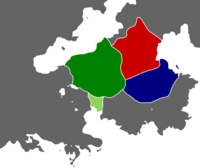Viragstag
This article is incomplete because it is pending further input from participants, or it is a work-in-progress by one author. Please comment on this article's talk page to share your input, comments and questions. Note: To contribute to this article, you may need to seek help from the author(s) of this page. |
Kingdom of Virag Viragstag | |||||||||
|---|---|---|---|---|---|---|---|---|---|
| 830–980 | |||||||||
|
Modern reconstitution of Viragstag royal banner | |||||||||
 The Lushyods dominated states in 850, with Viragstag in blue | |||||||||
| Capital | Viragzag | ||||||||
| Common languages | Lush | ||||||||
| Religion | Aletheism Alban Nazarism | ||||||||
| Government | Monarchy | ||||||||
| Sevr Korran | |||||||||
• 1022 - 1042 | Haldar I | ||||||||
• 957 - 980 (last) | Bezias III | ||||||||
| History | |||||||||
• Foundation of Viragzag | 830 | ||||||||
• Death in battle of Bezias III | 980 | ||||||||
| |||||||||
The Viragstag or Kingdom of the Lake was a medieval Lushyod state that existed in south-eastern Belisaria between the 9th and 10th centuries. It was founded in 829-830 when Havar I, a Lushyod prince from the Kingdom of the Drev led his retinue, his tribe, other adventurers, and their Ludic bondsmen on a southern migration to what is modern day Brumen. There, he founded the city of Viragzag on the northern shore of Lake Bluhen, then known by the Lushyods as Viragzod hence the name of both the city and the state. As monarch of the lake, Havar I built a strong state over Ludic, Southern Gothic, and Lushyod populations, and imposing its hegemony over what is northern Brumen.
Following the death of Havar, the kingdom entered a period of decline, locked in warfare with the southern kingdom of Waldreich and the other Gothic states while also struggling with internal conflicts between tribal lords. Back and forth of raids, counter-raids, sieges and localized battles would continue for the next 125 years until Viragzag was taken and its last king killed in battle ending Lushyod dominion over the region. The partition of Virastag among the victors and their partisans led to the creation of the modern constituent principalities of Brumen.
